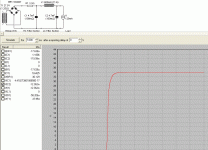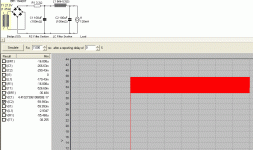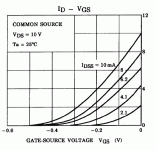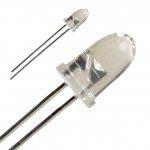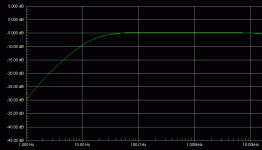This would be enough if you plan a pre filter. The only benefit is that it will kill the very high frequency spray that may modulate the slightly rising shunt reg output impedance way over the audio band. (Due to output capacitor impedance and cabling as well as some active elements factors). It will surely sound calm and black.
Attachments
For ripple itself you have not to worry, because as long as its minus is kept well over the CCS margin (taken care by the Vin-Vout dif recommended), it can not pass the CCS action. Its like having a huge coil. Actually it would be interesting to just use a minimum reactance filter with film capacitors, air core coil, and big ripple. The ripple won't pass the CCS and the quality of the components is superb. Their life expectancy, very long. This may sound better although it looks like an odd choice. Suppose we talk about a 24V Vout shunt as load in our examples, using a 25V 50VA mains trafo.
Attachments
nice idea Salas
this coil? http://www.selectronic.fr/article.asp?article_ref_entier=90.5720-2
I have nice speakers jantzen air coil flat copper 14awg 0,68mh 0,19r are usable?
this coil? http://www.selectronic.fr/article.asp?article_ref_entier=90.5720-2
I have nice speakers jantzen air coil flat copper 14awg 0,68mh 0,19r are usable?
That coil is a nice 1H 1A double coil in a good price. Depends on what you want it for. When having a regulator with CCS like our shunt, it is too much. If you are determined to use just passive filtering, coils in the Henry range are useful.
Your 0.68mH air coils could be useful in filtering some HF noise in a PSU as CLC. Tell me what exactly you have in mind. Voltage, current, circuit function.
Your 0.68mH air coils could be useful in filtering some HF noise in a PSU as CLC. Tell me what exactly you have in mind. Voltage, current, circuit function.
HI All
Part list digikey for dual rail +/- ,in 56Vdc out 44Vdc
4 P15W-2BK-ND 15r 2W 5% (100ma CCS)
4 P6.8W-2BK-ND 6r8 2W 5% (200ma CCS)
4 MPSA55GOS-ND
4 MPSA05GOS-ND
4 P470CACT-ND RES 470 OHM 1/4W 1%
4 CMF10.0HFCT-ND RES 10.0 OHM 1%
4 P47.0CACT-ND 47.0 1/4W 1%
4 P56.0CACT-ND 56.0 1/4W 1%
4 CMF1.00KHFCT-ND 1.00K 1%
4 CMF221HFCT-ND 221 1%
4 CMF33.2KHFCT-ND 33.2K 1%
4 CMF56.2HFCT-ND 56.2 1%
4 CMF47.5QFCT-ND 47.5 1%
4 IRFP240PBF-ND
4 IRFP9240PBF-ND
4 604-1065-ND CAP 100UF 35V
4 P10343-ND CAP 100UF 63V
4 1N4755ADICT-ND
12 67-1122-ND LED
2 BC550CGOS-ND
2 BC560CTACT-ND
Add for C4
4 470->1000mf 63v the best you can find as DR Salas suggest
as DR Salas suggest
Part list digikey for dual rail +/- ,in 56Vdc out 44Vdc
4 P15W-2BK-ND 15r 2W 5% (100ma CCS)
4 P6.8W-2BK-ND 6r8 2W 5% (200ma CCS)
4 MPSA55GOS-ND
4 MPSA05GOS-ND
4 P470CACT-ND RES 470 OHM 1/4W 1%
4 CMF10.0HFCT-ND RES 10.0 OHM 1%
4 P47.0CACT-ND 47.0 1/4W 1%
4 P56.0CACT-ND 56.0 1/4W 1%
4 CMF1.00KHFCT-ND 1.00K 1%
4 CMF221HFCT-ND 221 1%
4 CMF33.2KHFCT-ND 33.2K 1%
4 CMF56.2HFCT-ND 56.2 1%
4 CMF47.5QFCT-ND 47.5 1%
4 IRFP240PBF-ND
4 IRFP9240PBF-ND
4 604-1065-ND CAP 100UF 35V
4 P10343-ND CAP 100UF 63V
4 1N4755ADICT-ND
12 67-1122-ND LED
2 BC550CGOS-ND
2 BC560CTACT-ND
Add for C4
4 470->1000mf 63v the best you can find
Carawu:
Thorsten maybe sees higher second stage input impedance. If you want to use 10nF, the phase in the lows will start turning soon enough. Many engineers warn against early phase twist. Its a matter of what quality of coupling cap you have access to and how low your speakers go in practice I would think. It will also filter more acoustic feedback on the arm. It certainly will not cut some substantial audible spectrum (-1.5dB@20Hz) and if you have an excellent 10nF you may very well try it.
Thorsten maybe sees higher second stage input impedance. If you want to use 10nF, the phase in the lows will start turning soon enough. Many engineers warn against early phase twist. Its a matter of what quality of coupling cap you have access to and how low your speakers go in practice I would think. It will also filter more acoustic feedback on the arm. It certainly will not cut some substantial audible spectrum (-1.5dB@20Hz) and if you have an excellent 10nF you may very well try it.
Attachments
Hi guys,
I had definite plans on tackling a tube phono stage next, and well, I'll have to blame you guys for doing such a good job that I'm delaying the tube project and will do this one next, instead. the sk170 are yet to arrive. I'm hoping the MCM manufactured ones from Newark don't totally suck. One question though, since this is my first foray in jfet land, do the jfets need to be matched position-wise (left-right channel correspondence)?
the sk170 are yet to arrive. I'm hoping the MCM manufactured ones from Newark don't totally suck. One question though, since this is my first foray in jfet land, do the jfets need to be matched position-wise (left-right channel correspondence)?
I have a Grado black, so it's the MM version publised here that will get done, and for the psu I'll probably start with a couple of 12V batteries in series, then move up to a proper supply.
Anyway, salas, great job, thanks for keeping this going and improving it all the time.
I had definite plans on tackling a tube phono stage next, and well, I'll have to blame you guys for doing such a good job that I'm delaying the tube project and will do this one next, instead.
I have a Grado black, so it's the MM version publised here that will get done, and for the psu I'll probably start with a couple of 12V batteries in series, then move up to a proper supply.
Anyway, salas, great job, thanks for keeping this going and improving it all the time.
- Home
- Source & Line
- Analogue Source
- Simplistic NJFET RIAA
